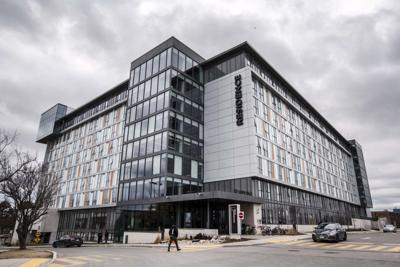In whatÔÇÖs being described as one of the largest mass layoffs in OntarioÔÇÖs history, more than 10,000 college faculty and staff have been let go and more than 600 college programs suspended or cancelled over the past year. The total figures, being made public for the first time, highlight the deep impact of an ongoing financial crisis fuelled by falling international student enrolment and allegations of institutional mismanagement.
ÔÇťThese are huge numbers; the human toll of this is massive,ÔÇŁ said OPSEU/SEFPO president JP Hornick, adding the union had to ÔÇťfight tooth and nailÔÇŁ to get the figures before they were disclosed in an .
ÔÇťThis is one of the largest mass layoffs in Ontario’s history,ÔÇŁ Hornick said, adding, ÔÇťThis is bigger than Hudson’s Bay,ÔÇŁ which laid off 8,000 employees across Canada this spring.
The post-secondary layoffs and program cuts ÔÇö spread across OntarioÔÇÖs 24 public colleges ÔÇö have hit both urban and rural communities and nearly every discipline, from business, engineering and nursing to culinary arts, hospitality and forest management, with Centennial, one of the provinceÔÇÖs largest colleges, suspending a high of 116 programs, according to the union. For more than a year, in a pace that quickened last fall, Ontario colleges, one after the other, announced they were suspending intake of new students or closing campuses and offering volunteer exit plans to staff.
Despite the scale of upheaval, efforts to get accurate system-wide data were, according to the union, repeatedly met with resistance from individual colleges and the the government-mandated bargaining agent for the colleges. Hornick said it was only through the faculty arbitration process that the full numbers were published, confirming data that the union had been attempting to collect on its own.
However, Graham Lloyd, CEO of the College Employer Council, said ÔÇťany suggestion that OPSEU has not been made aware and regularly updated about the challenges currently facing colleges is inaccurate,ÔÇŁ noting that all colleges have designated union committees that are consulted and ÔÇťare intimately involved in the process and aware of the numbers involved in advance of any actual layoffs.ÔÇŁ
OntarioÔÇÖs colleges previously employed around 60,000 faculty and staff, meaning the layoffs ÔÇö affecting full-time and part-time positions ÔÇö have cut roughly one-sixth of the workforce.
These figures emerge amid mounting financial strain on the college system, driven by a steep drop in international student enrolment, a provincial tuition freeze now in its sixth year, and per-student public funding that remains the lowest in Canada.
CanadaÔÇÖs overhaul of its study permit program in 2024 was designed to curb the unchecked growth of international students who pay more tuition. OntarioÔÇÖs colleges, in particular, came under scrutiny for driving the surge ÔÇö between 2012 and 2021, international enrolment soared by 342 per cent. Those numbers have dropped sharply since the introduction of a cap and┬á changes to post-graduation work eligibility.
With post-secondary institutions facing multimillion-dollar deficits, critics have also questioned the priorities and growth of administrative ranks. An earlier Star analysis of the provincial salary database of public employees going back to 2014 revealed the number of people with vice-president or dean in their titles increased 54 per cent at Ontario colleges (double the rate of enrolment).
ÔÇťThis is a manufactured crisis,ÔÇŁ says Hornick. ÔÇťThis is a system that has deliberately been starved of funding while management classes expand and their salaries explode and supports are not there for the students who need them.ÔÇŁ
Calling OPSEUÔÇÖs claims against the government ÔÇťbaseless and categorically false,ÔÇŁ the Ministry of Colleges and Universities noted ÔÇťin the last 14 months alone, we have provided unprecedented amounts of new funding to our publicly assisted postsecondary sector, with over $2 billion in new funding into our colleges and universities, on top of the $5 billion we put into the sector every year.ÔÇŁ
Bianca Giacoboni, press secretary to Minister Nolan Quinn, added that ÔÇťdecisions related to programming, campus closures, human resources, operational and budgeting decisions lie solely with each institution. As we always have, our government will continue making the necessary investments into our publicly assisted system to ensure our students get into programs that launch successful careers and positively contribute to our economy.ÔÇŁ
Hornick, who said the union is worried about the potential for privatization as well as additional program closures, predicts an ÔÇťincreased hopelessnessÔÇŁ on college campuses this fall. ÔÇťYou’re going see a limited ability to pursue programs that are needed in specific communities.ÔÇŁ
The union, college workers and community members are gathering to ÔÇťfight backÔÇŁ on Wednesday afternoon at Centennial CollegeÔÇÖs Story Arts Centre╠řÔÇö a campus slated to close.
The Ontario college system “was designed to be community-based, to provide affordable, accessible post-secondary within the communities people live so that they could contribute to those local economies,”┬ásays Hornick, adding that “Ontario colleges train half a million students every year, in every possible sector that you can imagine.
“For this to happen on this scale, this isn’t just about the immediate loss of good jobs in those communities, this is also about the future of local, rural and northern economies.ÔÇŁ































To join the conversation set a first and last name in your user profile.
Sign in or register for free to join the Conversation